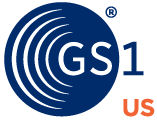Helpful Hint: GLNs and GTINs can be created using a GS1 Company Prefix. You can license a GS1 Company Prefix with the capacity to accommodate as many products or locations as you need. If you only need to identify a few, you can purchase individual GTINs or GLNs.
How to Use GS1 Standards for FSMA Rule 204
- Product & Location Identification
- Label Creation
- Shipping Data
- Other CTE Data

Assign GTINs and GLNs
Brand owners can assign a Global Trade Item Number® (GTIN®) to products on the Food Traceability List. These products and their product description Key Data Element (KDE) can be communicated to trading partners via the Global Data Synchronization NetworkTM (GDSN®) by using industry-recommended attributes. Physical location owners can identify locations with Global Location Numbers (GLNs), which are used for Traceability Lot Code Source and Ship To/From Location KDEs.

Encode Barcode with Product Data
Supply chain partners that transform, initially pack, or repack a product (or if they are the first land-based receiver) can create labels using a GS1-128 or GS1 DataMatrix barcode. Encoding the Global Trade Item Number® (GTIN®) and batch/lot into the barcode enables the sharing of the Traceability Lot Code. Pallets can be labeled with a GS1-128 barcode encoded with a Serial Shipping Container Code (SSCC).
Helpful Hint: There are two barcodes primarily used in the food supply chain. GS1-128 barcodes can include a wide variety of attribute data such as batch/lot information, serial number, expiration date, or country of origin. With the ability to hold additional attributes, 2D barcodes like the GS1 DataMatrix are becoming popular in general distribution.

Exchange Shipping Data
Supply chain partners can follow best practice for capturing and sending Shipping Key Data Elements (KDEs) electronically using Advance Ship Notices (ASNs).
Helpful Hint: ASNs should be used together with pallet Serial Shipping Container Code (SSCC) labels so when they're scanned, they can reference the ASN in the warehouse management system, which has all the other shipping information.

Exchange Critical Tracking Event Data
Along with shipping, the U.S. Food and Drug Administration (U.S. FDA) Food Safety Modernization Act Traceability Rule (FSMA Rule 204) requires capturing and sharing data from other supply chain processes. To help facilitate communication and recalls across the entire supply chain, the food industry is supporting the use of additional standardized electronic data sharing methods, including the Electronic Product Code Information Services (EPCIS).
Helpful Hint: EPCIS is a GS1 Standard that enables trading partners to share information about the physical movement and status of products, like Critical Tracking Events (CTEs) and Key Data Elements (KDEs). CTEs and KDEs can be mapped to specific data values for EPCIS.
More on How to Implement
The U.S. Food and Drug Administration (U.S. FDA) recommends using data standards to meet Food Safety Modernization Act Traceability Rule (FSMA Rule 204) requirements. GS1 Standards are already widely used in the food supply chain and can be mapped to Key Data Elements (KDEs) and Critical Tracking Events (CTEs). The Electronic Product Code Information Services (EPCIS) or the Global Data Synchronization Network™ (GDSN®) can help share KDEs for CTEs with your trading partners for smoother recalls.
For additional details, our readiness checklist can help you identify who in your organization to involve, how to create a traceability assessment plan, and more.
Frequently Asked Questions
The requirements of the Final Rule apply to all persons or companies who manufacture, process, pack, or hold foods on the Food Traceability List (FTL) (unless an exemption applies), regardless of whether the person/company is in the United States or a foreign country.
The U.S. Food and Drug Administration (U.S. FDA) outlines the requirements for recordkeeping as original paper records, electronic records, or true copies (such as photocopies, pictures, scanned copies, or other accurate reproductions of the original records). Electronic records may include valid working electronic links to the information required to be maintained under this subpart. The required records must be made available to an authorized U.S. FDA representative upon request within 24 hours, along with any information needed to understand these records.
While the original deadline was January 20, 2026, the U.S. Food and Drug Administration (U.S. FDA) announced its intention to extend the deadline into 2028.
A Global Trade Item Number® (GTIN®) is a GS1 Identification Key used to identify a trade item, while the Global Location Number (GLN) is used to identify locations. The U.S. Food and Drug Administration (U.S. FDA) has defined a set of metrics called Key Data Elements (KDEs) that correspond to different events in the supply chain known as Critical Tracking Events (CTEs). A KDE such as the GTIN can be tied to a CTE such as a GLN.
You can keep your Global Location Number (GLN) information private or share only with specific trading partners and/or the U.S. Food and Drug Administration (U.S. FDA). By default, when you publish a GLN, it is shared with all GS1 US Data Hub Location View/Use subscribers—and with users globally and freely via the Verified by GS1 service. To change this default setting, click the Profile icon and then navigate to the Data Hub Settings and then the Default Share Settings link. Uncheck the box for Share Your Locations (GLNs). Then click the Save Settings button.



